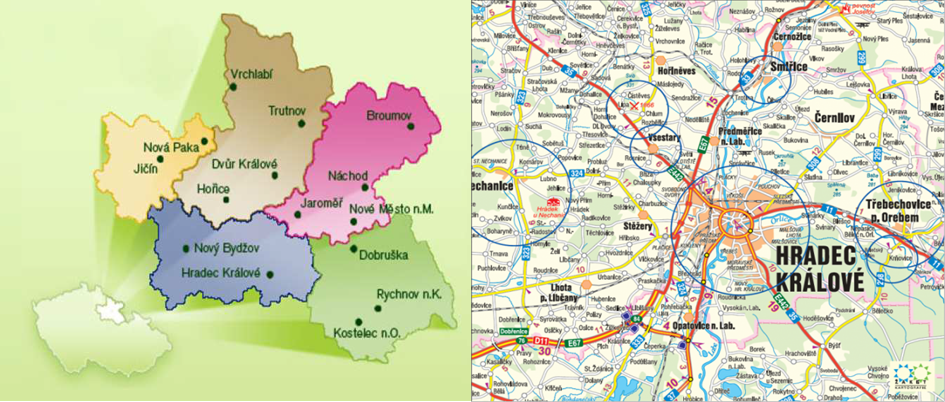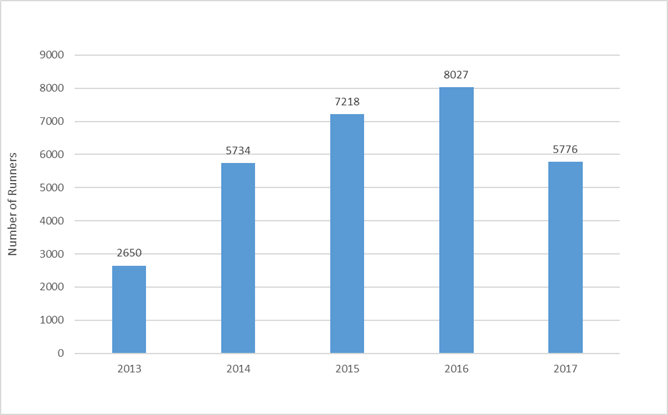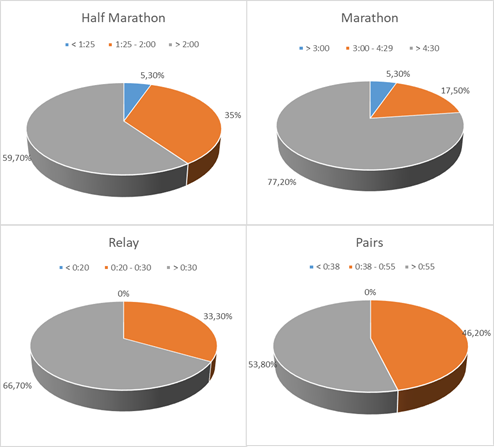Abstract
Running races appeal to both professionals and amateurs and they can give an opportunity for personal development. The study examines how the number of running races held in Hradec Králové and the number of participants developed in time and what are the major characteristics of runners. The purpose of the study is to describe and analyse the development of number of long-distance running races and their attendance in the tourist region of Hradecko in the period of five years (2013 – 2017) and to describe the major characteristics of participants of OlfinCar Half Marathon and ČSOB Marathon of Hradec Králové. Main methods of data collection were questionnaire, interview and content analysis. A questionnaire survey was carried out among the selected 308 participants of OlfinCar Half Marathon and ČSOB Marathon 2016. Major participant’s characteristics were described with focus on performance level, motivation and use of basic tourist services. In the given period there was the overall increase both in the number of long-distance running races (by 114 %) and participants (by 118 %). The results of the questionnaire survey provided major participant’s characteristics. There were 61.2% amateur runners of performance level, 33.8% amateur beginners and only 5% professionals. Among the most frequent motives there were course, setting and atmosphere. Running has been popular in recent years. An increase in people engaged in running as their leisure time activity can be seen in the Czech Republic. This is supported by the findings of the study of Hradec Králové.
Keywords: RunnerPerformanceMotivationHalf MarathonAmateur
Introduction
Running can be perceived as a social phenomenon. Increased interest can be seen in recreational running, being simply perceived as a means to improve physical fitness. Running races appeal to both professionals and amateurs and they can give an opportunity for personal development, not only in terms of physical, but also psychological and social aspects. Running in the Czech Republic gained in popularity in the last years, as confirmed by the Czech Athletics Federation (2015). In 2015 there were 133 083 athletes who participated in some of the races held in the Czech Republic. Running races classification concerns the distance, course setting/terrain, and the competition level. This study focused on long-distance running, which is available to wide public, represented by a road running event of half marathon. The exact distance is 21.0975 km, which is half of the distance of marathon. Half marathon is commonly held with a marathon race within one event, using almost the same course with a late start, an early finish or shortcuts, similarly as in the example of the study of Olfin Car Half Marathon and ČSOB Marathon of Hradec Kralove. Participation in distance running has grown in the recent years (Hanc, 2008, and Deaner, 2013). Except for the physical benefits, participation in a running race provides an intense experience, which can be benefitted in recreational runners in the psychological level. Feelings of happines are to be found by experiencing the present moment (Killingsworth & Gilbert, 2010). Optimal experience is described in the theory of “flow” (Bonaiuto et al., 2016). Growing attendance in half marathons was concerned by Hanc (2008). Half marathon provides a challenging distance, but apart from marathon does not require the same intensity of training. Hanc (2008) considers the distance a “must do” for thousands.
Problem Statement
The level of performance in running
Dovalil and Choutka (2004) apply the division of sport activities to three levels according to the performance characteristics of individuals: a recreational level, a level of performance, and a top level. Recreational levels of running can be achieved by people of all ages who are involved in running in their free time in an organized way (in the context of sport clubs, organizations, associations, etc.) or in a non-organized way. As the main motivation for recreational run, Dovalil and Choutka (2004) mention exercise, entertainment in the natural and social environment, maintenance or improvement of the health and mental state and improving fitness. Recreational sport activities generally maintain and strengthen friendly relations, which expresses the essence of their socialization function. Roberts (2014) refers to the athletes of recreational performance as athlete’s beginners, or the so called beginner amateurs, the level of performance as advanced amateurs and the top level as professionals. The top level is described by Dovalil and Choutka (2004) as the highest level of performance, which is no longer only within the free time, but athletes are adapting their lifestyle. Recent studies are often concerned with motivation of amateur runners, especially beginners, through designing common extrinsic motivations such as health concerns or external reward system (Knaving et al., 2015), e. g. a medal for every half marathon finisher. In the investigation of the needs of advanced amateur runners, Knaving et al. (2015) suggested main design themes in: festival, competition, practicalities, togetherness, and support. Although all the performance levels are able to participate in long-distance runs, there are specific differences within the groups. Prieto (2017) evaluated psychological aspects of amateur runners at the beginner and advanced performance level. The results indicated that less experienced runners (training 1 or 2 days a week for less than 1 year) had higher cognitive anxiety and lower somatic anxiety compared to the runners with bigger training volumes. The runners with a weekly volumes of more than 50 km also had greater enthusiasm and interest in the competition. Aspects of physical motivation were applied in the research of ultra-distance runs, which represent the top performance level (Ferrer et al., 2015). They found out that especially older runners seemed to be more motivated to run for the perceived physical benefits (e. g. health and body weight).
Running races and sport tourism
A general motivation for sport tourism can be found in combination of a quest and escape (Schwartzhoffová, 2009). In this study, sport tourism is represented through running, by both active and passive participation in running events, organized for both commercial and non-commercial purposes, associated with staying outside home or workplace. The importance of sport tourism from the economic point of view is seen in the ability to generate revenue from sponsors and media, with a positive impact on construction of infrastructure in the given destination and, last but not least, generating multiplicating effect (Malcolm, 2008). There is a growing interest in sport tourism, which can be explained by combining globalization and democratization factors, supported by economic and political influences (Hinch and Higham, 2011). The authors found these trends in the growing demographic profile of those interested in sport activities, increasing the interest in a healthy lifestyle in the western world, increasing the demand for actively spent holiday time, increasing the interest in sport events related to restoration of local infrastructure and supporting the development of other travel services. The impacts on the local community can be seen in the social and cultural effects (Reverté and Pérez, 2018). Sport can also be used as an enhancement factor in the image of destination. The attractiveness of tourism is represented by a primary potential that can be either man-made (anthropogenic) or natural. The events rank among the anthropogenic conditions that make it possible to increase the potential of tourism. Event management belongs to major motivational factors for tourism participation. They can play an important role in the corporate and marketing planning of most destinations (Getz, 2008). In the field of running races the quality of service is recognized as an important factor of an intent to return and thus increase the economic contribution. Andam et al. (2015) used a model to evaluate service quality of sport conferences in sport event tourism in dimensions including the venue, conference, access, and trip quality.
Research Questions
How did the number of long-distance running races held in Hradec Kralove (Czech Republic) and its close surroundings develop in the last five years 2013 – 2017? How did the attendance of the races develop in the given time period? What are the major characteristics of runners?
Purpose of the Study
The purpose of the study was to describe and analyse the development of the number of long-distance running races and the attendance of the running races held in the tourist region of Hradecko in the last few years (2013 – 17). A partial aim was to find out what are the major characteristics of the selected participants of OlfinCar Half Marathon and ČSOB Marathon of Hradec Kralove.
Research Methods
Main methods of data collection were content analysis, questionnaire, and interview. Content analysis of relevant sources focused on long-distance running races, both city and trail, held in the period of 2013 – 2017. The defined area was the tourist region of Hradecko (see the right part of the Figure

Selection criteria for further analysis was the length of at least three kilometres, an existing and available evidence of attendance in at least two consecutive years of the given period and the minimum of 50 participating runners. The number of runners equalled to the summation of the participants of all the competing categories in each run, calculated based on the electronic timing evidence. The basic sample comprised 30 running races, out of which 18 complied with the selection criteria.
A questionnaire survey was carried out among the selected 308 participants of OlfinCar (later as OC) Half Marathon and ČSOB Marathon 2016 (singles, pairs or relays), to find out major runners’characteristics. The race was selected as the running event with the biggest attendance of all the selected runs in all the followed five years (2744 runners in 2016). The event has also been ranked as a top ten running race in the Czech Republic in 2016 and 2017 (Sportvisio, 2018). The questionnaire was distributed to the runners either online or personally as a part of their registration procedure. The number of respondents represents 11 % of all the runners participating in OC Half Marathon and ČSOB Marathon. The collected data were evaluated in quantitative analysis by means of descriptive statistics. Major participant’s characteristics were described in terms of a competing category, performance level, motivation, repeated participation, willingness to use the accompanying programme, use of basic tourist services or visiting tourist sights/attractions, and having an accompanying person.
Findings
The aim of the study was to analyse long-distance running races held in Hradec Kralove and to examine how their attendance developed in time, in the period of the last five years (2013 – 2017). In the given period there was the overall increase both in the number of races (by 114 %) and participants (by 118 %). The first research question concerned with long-distance running races held in Hradec Kralove and its close surroundings. Their description and analysis preceded further research in the development of the attendance. The basic sample comprised 30 running races. They included all the races in Hradecko, both city, cross country or combined, held for the public, with a minimum distance of 3 km. 18 races complied with the selection criteria for further analysis providing the evidence of attendance in at least two consecutive years. Except for two races, either all the course or its part was situated directly in Hradec Kralove. A specific opportunity of Hradec Kralove was found in the property of the city forests, owned by the public limited company of City Forests of Hradec Kralove. The local forests provide many kilometres of cross country trails as well as an asphalt cycle tracks circuit in the length of 10.5 km. 9 races were characterized as cross country, 5 took place in the city centre and 3 were combined, which is also the case of OC half marathon and ČSOB Marathon of Hradec Kralove. The distance of the majority of races ranged from 5 to 10 kilometers. The year-on-year increase in the number of races was evaluated in relative frequency. The number of races that fulfilled the selection criteria increased in time, from 7 races in 2013 to 15 in 2017. The biggest increase was in between 2013 and 2014, (by 75 %). In 2015 the increase continued by further 21.4 %. In 2016 the number of races stayed the same. In the last examined year there was a decrease by 2 races (11 %) The reason was that one of the analyzed races was cancelled and the other was moved into the neighbouring city of Pardubice.
The second research question focused on how the number of runners in Hradec Kralove and its surroundings changed in time. The results are illustrated in the Figure

The performance level was evaluated based on the division scales by Roberts (2014) according to the expected finish time of the respondents. There were 61.2% advanced amateur runners, 33.8% beginner amateurs and only 5% professionals. Detailed analysis of individual disciplines is shown in the Figure

Among the most frequent motives to participate the race there were course, setting and atmosphere, in the next place there were factors of individual performance, with main focus on the finish time, and social psyching-up in the running team. Participant’s medal and visit of the city appeared to be of the least importance. This is reliable with the results concerning the participants’ intention to visit some tourist attractions or sights. Only 25.5 % of the respondents reported their intention to visit the city and have some extra programme as an added value to the running race as such. Based on the major characteristics of the research sample, most typical half marathon participants can be described as 1day visitors of the city who came by their own car, mainly did not use the accommodation services either visited tourist sights or attractions, or the accompanying sport programme offered by the organizers in the start/finish space. As to the basic local services, the biggest use was in catering. 56 % participants visited some catering facility. Concerning their intention to revisit the event, 79.5 % of runners of OC Half marathon and ČSOB Marathon planned to participate in the next year as a part of their motivation in the following season. 39.9 % runners had also taken part in the same racing event in the preceding year. The detailed characteristics of Olfin Car Half Marathon and ČSOB Marathon of Hradec Kralove are shown in the figure

Discussion
OC half marathon and ČSOB marathon can be characterized by the specific typology for sport tourism events (Kotíková and Schwartzhoffová, 2008) as an event, which is: sports, open, outdoor, organized by a non-profit organization, medium size, regional, short-term, annual, participant-oriented, recreational and performance level. In order to characterize the competitors as tourism participants, it is necessary to think about the motives. The effect of these motifs is also related to runners’ willingness to overcome certain distance from their place of living to the venue. The questionnaire survey showed that most participating runners were willing to travel a distance up to 100 km. The OC Half marathon ČSOB Marathon of Hradec Kralove is ranked among the sport event of a regional significance (Kotíková, 2013), because participants come from the region. Since it is a sporting event, the sporting activity itself (individual performance in the race) should be considered as a primary motive. However, the questionnaire survey suggested the most important motives to be the course, setting and atmosphere of the race. The organizers benefitted from the unique combination of both city and forest surroundings to create a unique long-distance running race. The natural environment can intensify emotionalized perception of a present moment flow (Jirásek, 2016). The participants also appreciated the atmosphere to be a strong motivational factor, which support the social function of sport events (Hinch and Kono, 2018). Based on the aforementioned results the OC Half marathon ČSOB Marathon of Hradec Kralove can be characterized in terms of motivation within tourism as a sport event of both recreational and performance level.
Running in the Czech Republic gained in popularity in the last years, as confirmed by the Czech Athletics Federation (2015). For example in 2015 there were 133 083 athletes who participated in some of the races held in the Czech Republic. The increasing interest of runners was verified by this study focused on the attendance in Hradec Kralove and its closed surroundings. Both the number of races held in the given tourist region and the total number of participants increased more than twice in the last five years. The increase in the number of visitors to the destination, both due to participation in the event itself and the subsequent attendance in the destination, can be considered one of the most significant positive impact of the given sport event (Kotíkova, 2013). Recent research also concerns with an intention to revisit a sport event or the place (Romiti & Sarti, 2016; Wicker, Hallmann & Zhang, 2012; Yeh, Hua, & Huang, 2016; Shonk & Chelladurai, 2008). The quality of service offered in the given sport tourism destination is an important predictor of an athlete’s or accompanying person’s intension to revisit the destination. The highest use of basic tourism service in OC Half marathon and ČSOB Marathon was in catering. 56.5% runners visited some catering facility in the city. Moreover, the number was approximately doubled by their company. Runners usually had one accompanying person who participated in the overall positive effect on catering services. On the other hand, the accommodation service was only used by 4.5% of the participants and their company. Most participants came for one day, probably due to the fact that most runners came from the region of Eastern Bohemia.
Only 25 % of participants planned to visit local tourist sights and attractions. The findings are in agreement with Wicker, Hallmann & Zhang (2012) in athletes and their intention to revisit the city and a marathon race. The runners were more likely to revisit the marathon events, but not the city. According to Schwartzhoffová (2009) some sport events are so attractive that the attendance alone is enough for visitors to create a strong, high-quality experience without the need for additional services. Such events become permanently associated with a particular place as significant tourism event. OC Half Marathon and ČSOB Marathon represent one of the most characteristic sport events for the city of Hradec Králové. Romiti and Sarti (2016) confirmed the venue quality was to be a key determinant of the service quality in the field of active sports tourism. This can be supported in the study of OC Half Marathon and ČSOB Marathon of Hradec Kralove.
Running has been gaining in popularity in the recent years. The attendance has increased not only in racing events but also in charity runs to raise money for beneficial projects. The findings of the example study of Hradec Kralove suggests that the potential of running to be a social phenomenon is high. An effect on quality of life can be seen in not only physical aspects, but also psychological and social ones. Through the most common motifs running can be perceived as a means of personal development in terms of social psyching-up and acquiring new experiences.
Conclusion
Running has been popular in recent years. An increase in people engaged in running as their leisure time activity can be seen in the Czech Republic. This is supported by the findings of the study of Hradec Králové and its close surroundings. Running events have potential to support the development of tourism, which was applied in this research. Increasing in popularity of running can be supported by the evidence of the overall increase in the number of races held in Hradecko and in the total number of finishers within the years 2013 – 2017.
Acknowledgments
The paper was supported by the Internal Grant Project of the Faculty of Informatics and Management, University of Hradec Kralove in the Czech Republic 1907/2018.
References
- Andam, R., Montazeri, A., Feizi, S. & Mehdizadeh, R. (2015). Providing a multidimensional measurement model for assessing quality of sport tourism services: Empirical evidence from sport conference as sport event tourism. Iranian Journal of Management Studies, 8, pp. 607-629.
- Bonaiuto, M., Mao, Y., Roberts, S., Psalti, A., Ariccio, S., Cancellieri U. G. & Csikszentmihalyi, M. (2016). Optimal Experience and Personal Growth: Flow and the Consolidation of Place Identity. Frontiers in Psychology. 7:1654. doi:10.3389/fpsyg.2016.01654.
- Czech Athletics Federation (2015). Byly oceněny top české běhy 2015. [online]. [cit. 2018-01-09]. Retrieved from: http://www.atletika.cz/aktuality/byly-oceneny-top-ceske-behy-2015/.
- Deaner, R. O. (2013). Distance running as an ideal domain for showing a sex difference in competitiveness. Arch Sex Behav. 42(413). doi:10.1007/s10508-012-9965-z.
- Dovalil, J. & Choutka, M. (2004). Sport. In: Olympismus. Praha, CZ: Olympia, pp 9-19.
- Ferrer, D. A., Baumann, C. W., Brandenberger, K. J., Ellis, R. & Otis J. S. (2015). Physical Motivation Influences Race Performance Over a 24-hour Ultra-Marathon. International Journal of Sport Studies. 5(10), pp. 1162-1169.
- Getz. D. (2008). Event tourism: Definition, evolution, and research. Journal of Tourism Management, 29, pp. 403-428. doi: 10.1016/j.tourman.2007.07.017.
- Hanc, J. (2008). Sometimes half is better than whole. NY Times [online]. [cit. 2018-09-09]. Retrieved from: https://www.nytimes.com/2008/07/24/fashion/24fitness.html.
- Hinch, T. & Higham, J. (2011) Sport tourism development. Buffalo: Channel View Publications.
- Hinch, T. & Kono, S. (2018). Ultramarathon runners’ perception of place: a photo-based analysis. Journal of Sport and Tourism. 22(2), pp. 109-130. doi: 10.1080/14775085.2017.1371065.
- Jirásek, I. (2016). Doxa and epistémé of the theory of education through direct experience. Pedagogika. 66(2), pp. 154-178.
- Knaving, K., Wozniak, P., Fjeld, M. & Bjӧrk, S. (2015). Flow is not enough: Understanding the needs of advanced amateur runners to design motivation technology. Conference on Human Factors in Computing Systems - Proceedings, pp. 2013-2022. doi: 10.1145/2702123.2702542.
- Killingsworth, M. A. & Gilbert, D. T. (2010). A wandering mind is an unhappy mind. Science. 330(6006), p.932.
- Kotíková, H. (2013). Nové trendy v nabídce cestovního ruchu. Praha, CZ: Grada.
- Kotíková, H. & Schwartzhoffová, E. (2008). Nové trendy v pořádání akcí a událostí (events) v cestovním ruchu. Praha, CZ: Ministerstvo pro místní rozvoj ČR.
- Malcolm, D. (2008). The SAGE dictionary of sports studies. LA: Sage.
- Prieto, A. J. (2017). Sport experience, anxiety and motivation in popular runners. Cuadernos de Psicologia del Deporte. 17(1), pp. 51-58.
- Reverté, F. G. & Pérez, S. M. (2018). Cultural and social impacts of events held in tourism destinations. A managers' perception point of view. Cuadernos de Turismo. 40, pp. 339-362. doi: 10.6018/turismo.40.309741
- Roberts, M. (2014). Začni běhat. Prague, CZ: Slovart.
- Romiti, A. & Sarti, D. (2016). Service quality experience and customers’ behavioural intentions in active sport tourism. Modern Economy, 7, 1361-1384. doi: 10.4236/me.2016.712127
- Shonk, D. J. & Chelladurai, P. (2008). Service quality, satisfaction, and intent to return in event sport tourism. Journal of Sport Management, 22(5), pp. 587-602.
- Schwartzhoffová, E. (2009) Sportovní event a jeho význam v cestovním ruchu. In: Management a marketins sportu a cestovního ruchu. Ústí nad Labem: Západočeská univerzita. Pp. 157-162. ISBN 978-80-244-3438-4.
- Sportvisio (2018). Top běžecké akce 2017. [online]. [cit. 2018-08-28]. Retrieved from: http://www.sportvisio.cz/aktuality-sportvisio/380-top-bezecke-akce-2017.html.
- Turistický region Královéhradecko (2014). Manuál pro odborníky v cestovním ruchu [online]. 2014 [cit. 2017-01-28]. Retrieved from: http://docplayer.cz/17289870-Turisticky-region-kralovehradecko.html#show_full_text.
- Yeh, C. C., Hua, K. T. & Huang C. H. (2016). Service quality improving effects and recreational benefits for sports tourism – A case study. Tourism economics, 22, pp. 1332-1337. doi: 10.1177/13548166116672357.
Copyright information

This work is licensed under a Creative Commons Attribution-NonCommercial-NoDerivatives 4.0 International License.
About this article
Publication Date
28 February 2019
Article Doi
eBook ISBN
978-1-80296-055-6
Publisher
Future Academy
Volume
56
Print ISBN (optional)
-
Edition Number
1st Edition
Pages
1-719
Subjects
Pedagogy, education, psychology, linguistics, social sciences
Cite this article as:
Hrušová, D. (2019). Development Of Running Races And Their Attendance: A Study Of Hradec Králové. In S. Ivanova, & I. Elkina (Eds.), Cognitive - Social, and Behavioural Sciences - icCSBs 2018, vol 56. European Proceedings of Social and Behavioural Sciences (pp. 421-431). Future Academy. https://doi.org/10.15405/epsbs.2019.02.02.46

